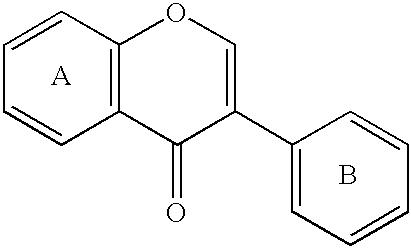Extraction of flavonoids
a technology of extracting flavonoids and flavonoids, which is applied in the field of extracting flavonoids, can solve the problems of high yield, inability to frequently, and use of significant quantities of flammables, and achieves the effect of simple and convenient method of extracting flavonoids and high yield
- Summary
- Abstract
- Description
- Claims
- Application Information
AI Technical Summary
Benefits of technology
Problems solved by technology
Method used
Image
Examples
example 1a
[0066]A sample of approximately 1 kg of leaves on (long) stems of subterranean clover (Trifolium subterraneum L.) grown in the South West of Western Australia over the 1999 winter, was collected in early October, stored for ca 20° C. for one day and 5° C. for 10 days. The leaves of approximately 0.5 kg of this stored material were cut off and retained in a plastic bag.
[0067]25 g of the clover leaves were mixed with 50 g of acid washed wet white sand and ground in a mortar and pestle for 3.5 minutes. The ground leaf and sand material was transferred to a sealed plastic bag and 10 minutes was heat treated at approximately 62° C. for 20 minutes.
[0068]Next day the heat treated material was transferred to a beaker and 200 mL of deionised water added, with stirring 5M sodium hydroxide solution was added from a dropper to raise the pH of the suspension to pH 9.6. The coarse fibrous material was removed by passing the suspension through a triple layer of fine gauze, the sludge like material...
example 1b
[0073]A sample of approximately 1 kg of leaves on (long) stems of subterranean clover (Trifolium subterraneum L.) of the cultivar Trikkala grown in the South West of Western Australia over the 1999 winter, was collected in early October, stored at ca 20° C. for one day and 5° C. for 10 days.
[0074]The leaves of approximately 0.5 kg of this stored material were cut off and retained in a plastic bag. 25 g of the clover leaves were mixed with 50 g of acid washed wet white sand and ground in a mortar and pestle for 3.5 minutes. The ground leaf and sand material was transferred to a sealed plastic bag for 10 minutes and then was heat treated at approximately 62° C. for 20 minutes.
[0075]Next day the heat treated material was transferred to a beaker and 200 mL of deionised water added, with stirring 5M sodium hydroxide solution was added from a dropper to raise the pH of the suspension to pH 12.0. The coarse fibrous material was removed by passing the suspension through a triple layer of fi...
example 1c
[0079]A sample of approximately 1 kg of leaves on (long) stems of subterranean clover (Trifolium subterraneum L.) of the cultivar Trikkala grown in the South West of Western Australia over the 1999 winter, was collected in early October, stored at ca 20° C. for 1 day and 5° C. for 10 days. The leaves of approximately 0.5 kg of this stored material were cut off and retained in a plastic bag.
[0080]26 g of the clover leaves were mixed with 52 g of acid washed wet white sand and ground in a mortar and pestle for 3.5 minutes. The ground leaf and sand material was transferred to a sealed plastic bag for 10 minutes and then was heat treated at approximately 62° C. for 20 minutes.
[0081]Next day the heat treated material was transferred to a beaker and 200 mL of deionised water added, with stirring 5M sodium hydroxide solution was added from a dropper to raise the pH of the suspension to pH 12.0. The coarse fibrous material was removed by passing the suspension through a triple layer of fine...
PUM
| Property | Measurement | Unit |
|---|---|---|
| temperature | aaaaa | aaaaa |
| temperature | aaaaa | aaaaa |
| pKa | aaaaa | aaaaa |
Abstract
Description
Claims
Application Information
 Login to View More
Login to View More - R&D
- Intellectual Property
- Life Sciences
- Materials
- Tech Scout
- Unparalleled Data Quality
- Higher Quality Content
- 60% Fewer Hallucinations
Browse by: Latest US Patents, China's latest patents, Technical Efficacy Thesaurus, Application Domain, Technology Topic, Popular Technical Reports.
© 2025 PatSnap. All rights reserved.Legal|Privacy policy|Modern Slavery Act Transparency Statement|Sitemap|About US| Contact US: help@patsnap.com


